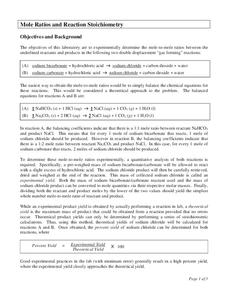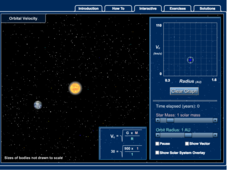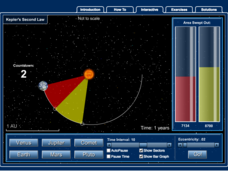Santa Monica College
Chemical Equilibrium and Le Chatelier’s Principle
Henri-Louis Le Chatelier wrote many papers throughout his 85-year life, but he is remembered for one of his earliest discoveries, now known as Le Chatelier's Principle. The final lesson in an 11-part series encourages young chemists to...
Santa Monica College
Mole Ratios and Reaction Stoichiometry
Stoichiometry sounds complicated, but it really means the study of the amount of substances involved in a reaction. The sixth lesson plan in an 11-part series has scholars use stoichiometry to find the theoretical yield of a reaction....
McGraw Hill
H-R Diagram
As a star ages its composition, size, and temperature change. Using an interactive simulation, learners explore these changes over the lifetime of a star. They see the change in temperature and luminosity graphically and a visual...
McGraw Hill
Solar System Builder
Create your own solar system using a simulation. Young scientists explore the components of a stable solar system through trial and error. Using the simulation, they place planets and watch as they orbit safely or cause fatal collisions.
McGraw Hill
Retrograde Motion
How does Mars move both eastward and westward in Earth's sky? A simple interactive describes the concept of retrograde motion using both color and graphic models. Learners understand that the speed of the orbit accounts for Mars' change...
McGraw Hill
Cosmology
Explore the birth and possible death of the universe. An interactive simulation allows learners to manipulate the Hubble Constant to model the expansion of the universe from birth. Varying the constant provides different scenarios for...
McGraw Hill
The Bohr Atom
Elements don't have fingers, but they have fingerprints! An interactive simulation gives young scientists the opportunity to study orbital changes of an atom and the corresponding spectrum reading. They realize how each atom has a unique...
McGraw Hill
Blackbody Radiation Interactive
Noting the color of a star is equivalent to taking its temperature! A creative lesson describes the connection between a star's temperature and the color it emits. As pupils interact with a simulation, they learn how to connect the...
McGraw Hill
Stellar Spectroscopy Interactive
Stars seem to be a far away mystery... but it turns out we know much more about stars than one would think! An engaging lesson shows learners how to read a light spectrum to determine the temperature and chemical makeup of a star. They...
McGraw Hill
Stellar Parallax Interactive
How are scientists able to measure distances between stellar bodies? Turns out it's not very easy! Learners explore the process of trigonometric parallax as the method of determining these distances. They experience the same challenges...
McGraw Hill
Planetary Variations Interactive
Planetary atmospheres vary greatly from planet to planet. Explore these variations by experiencing the motion of the atmospheric molecules through an engaging simulation. Pupils discover that temperature and mass contribute to the...
McGraw Hill
Orbital Velocity Interactive
Why does it take Pluto 90,000 days to orbit the sun, but it only takes Mercury 88 days? An interactive lesson helps pupils find a connection between the speed of orbit and distance a planet is from the sun. The simulation allows for...
McGraw Hill
Neutron Stars Interactive
The universe is full of sources of energy. Explore the energy of pulsars with your classes through a simulation. An interactive lesson allows learners to manipulate the angle of rotation of both the earth and the pulsars. A real-time...
McGraw Hill
Kepler's Second Law Interactive
Kepler decided to think outside the box and discovered that planets orbit in elliptical patterns. An engaging activity demonstrates the elliptical orbit pattern in relationship to the area of a planet to explain Kepler's Second Law....
McGraw Hill
Gravity Variations Interactive
What would a baseball game look like on the moon? Probably a lot of home runs! A creative activity explores the motion of a projectile on the surface of different bodies in the solar system. Participants adjust the angle and velocity of...
McGraw Hill
Escape Velocity Interactive
How hard do you need to throw a ball in the air so that it never returns? Scientists call this measure the escape velocity. Classes can explore this concept through an intriguing interactive lesson. Pupils adjust velocities and observe...
McGraw Hill
Eclipse Interactive
Give your classes a visual model of a rare phenomenon. Learners use an interactive activity to explore the connection of location, tilt, and size to the occurrence of an eclipse. Pupils consider both solar and lunar eclipses throughout...
McGraw Hill
Binary Stars Interactive
A celestial body's distance from Earth makes studying its characteristics much more difficult. Learn how scientists use indirect measures to determine the size of stars. The interactive activity has individuals adjust the size of binary...
Santa Monica College
Titration of Vinegar
Titration calculations require concentration. The 10th lesson in an 11-part series challenges young chemists to use titration in order to determine the molarity and mass percent in concentrated vinegar. Analysis questions encourage...
Santa Monica College
Lewis Structures and Molecular Shapes
Learners practice drawing Lewis dot structures, build molecules with model kits, and predict molecular shapes using VSEPR theory. The combination of written work and hands-on reinforcement benefits young scientists.
Santa Monica College
Flame Tests of Metal Cations
Scientists used flame tests to identify elements long before the invention of emission spectroscopy. Young chemists observe a flame test of five metal cations in the fourth lesson of an 11-part series. Individuals then work...
Santa Monica College
Single and Double Displacement Reactions
If you aren't part of the solution, you are part of the precipitate! Young chemists learn about single and double displacement reactions including precipitation reactions, neutralization reactions, and gas forming reactions. They perform...
Santa Monica College
The Properties of Oxygen Gas
Scholars generate and collect pure oxygen through a decomposition reaction of hydrogen peroxide in the fourth instructional activity of an 11-part series. Then, they complete six investigations into the properties of oxygen.
Santa Monica College
The Composition of Potassium Chlorate
The third lesson in a series of 11 begins by using thermal decomposition of potassium chlorate to determine the mass percent of oxygen. Then a second activity allows scholars to demonstrate that the resulting residue is from a...

























